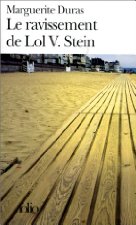
After watching and utterly falling for Alain Resnais's and Marguerite Duras's 1959 film Hiroshima mon amour back in March, I was so enamored of the language—sparse, yet compelling enough that I recited phrases from the film to myself for weeks after watching it—that I had to search out Duras's original screenplay and spend some time absorbing the words at a slower-than-speech pace. Doing so only increased my admiration for Duras's work here, while at the same time helping me realize how much the visual and audio elements of the film augment and alter the words spoken. Having read with interest Amateur Reader's recent post on watching and reading plays, it was an intriguing exercise to go back and read a screenplay of a film I've already watched and savored.
In particular, Elle's hypnotic near-monologue from the opening of the film makes a different impression when stripped of the haunting score by Georges Delerue and Giovanni Fusco, and of the shocking and heartbreaking newsreel footage of war devastation (and its counterpoint, near-abstract images of lovers' bodies). Emmanuelle Riva's cadenced delivery of these lines emphasizes the way in which Duras's prose veers, under pressure, into poetic verse and back out again. The score, in turn, underlines that growing pressure underlying Elle's narration, as she tries to convince her Japanese lover that she has seen Hiroshima, that she has witnessed and at some level understands the devastation of the war. Take the following passage, from close to the beginning of the film (all marks and emphasis mine):
Quatre fois au musée à Hiroshima.
J'ai regardé les gens. J'ai regardé moi-même pensivement, le fer. Le fer brûlé. Le fer brisé, le fer devenu vulnérable comme la chair. J'ai vu des capsules en bouquet: qui y aurait pensé? Des peaux humaines flottantes, survivantes, encore dans la fraîcheur de leurs souffrances. Des pierres. Des pierres brûlées. Des pierres éclatées. Des chevelures anonymes que les femmes de Hiroshima retrouvaient tout entières tombées le matin, au réveil.
J'ai eu chaud place de la Paix. Dix mille degrés sur la place de la Paix. Je le sais. La température du soleil sur la place de la Paix. Comment l'ignorer?
The meaning in English is more or less:
Four times at the museum in Hiroshima.
I watched the people. I myself watched, pensively, the metal. Metal burnt. Metal broken, metal become vulnerable like flesh. I saw the bouquet of bottle caps: who would have thought? The preserved human skins, floating, surviving, their suffering still fresh. The stones. Burnt stone. Shattered stone. The anonymous hair that the women of Hiroshima found, fallen out, on waking in the morning.
I was hot in Peace Square. Ten thousand degrees in Peace Square. I know it. The temperature of the sun in Peace Square - how could you not know it?
However, many of the rhymes and echoes (in particular the "eɪ" sound common among the bolded syllables above) don't translate into English. Try to read it in French even if you don't understand the words, and notice how the rhyming or echoing words are grouped together, often in the shorter sentences. The rhyming/echoing "eɪ" sounds are generally on the accented syllable, and often directly precede a comma or period, which strengthens the stress on those beats. They are repetitive yet syncopated, building on each other to create a rhythmic tension which is alleviated by the counterpoint of the longer sentences, which descend back into a more prose-like rhythm (although the underlined syllables create another, minor rhythmic line). The overall effect is insistent, incantatory. Elle is building a story, a representation that is meant to convince her lover of what she "knows," what we all "know": the devastation and cruelty of the atomic bomb at Hiroshima. But representations of something felt in the body tend to be problematic in Duras. The insistent yet fragile structure created by Elle's voice is cut short by Lui's stark refusal: "Tu n'as rien vu à Hiroshima, rien." (You saw nothing at Hiroshima, nothing.")
Although Duras communicates much of this rhythmic play via punctuation, the text alone simply does not have the power of the full filmic package.1 The score underlines everything I've been talking about with regard to the building rhythmic anxiety: frenetic piano, flute, and string parts underline brilliantly the tension during her speeches about the museum, while his refusals are marked by silence, or the single, elegant line of (I'm guessing?) a clarinet. Just to illustrate the exact points Duras is making, my analysis comes nowhere close to the experience of actually watching all elements come together:
The cuts back from the bomb footage to the lovers' bodies provide another method of contrasting the physical immediacy of Elle's current situation with the theoretical nature of her "knowledge" about the bomb. And the questions of reality versus representation are brought to yet another level by the fact that this is itself a piece of art, being viewed by an audience, yet it incorporates the same real newsreel footage that Elle keeps referencing. As the viewer, I feel I am coming face to face with the "reality" of the war, just as Elle feels she was brought face to face with it by going four times to the museum. My reaction was the same as hers: I wept. The impact of these images does not feel negligible, does not feel like something that can be so cleanly dismissed. And yet of course, my feeling is just as illusory as Elle's: our weeping does not indicate any privileged knowledge of Hiroshima under attack. That kind of knowledge is kept locked in the bodies of those who were there, and any attempt to communicate it in language (as Elle does with her own trauma later on) will lead only to forgetfulness, not to shared understanding.
Notes on Disgust
I've decided to jot down a few notes for each of my posts about how the book in question might make use of disgust, even if said book is not directly related to my Disgust Project. This is primarily so I can get a better idea what the most common uses of disgust might be.
Hiroshima mon amour is remarkable for how little disgust it elicits, considering its subject matter. The opening 15-minute montage, in particular, shows very graphic images of disfigurement following the atomic blast, yet (at least personally) I wouldn't say disgust is my primary emotion on viewing these images. I think this is because the disgust impulse has either been superseded by grief and pity, or has reached a tipping point of extremity into horror. (Since I'm American, there may also be a certain amount of cultural guilt around the knowledge that "we" were the ones responsible for the atrocities pictured. Despite the fact that the bomb project was not exactly a democratic decision and happened in any case long before I was born, and despite my strong dislike of nationalism, witnessing photographic evidence of the devastation wrought by one's own country is for some reason more upsetting than witnessing similar devastation wrought by others. As such, most of the disgust I feel when viewing these images is directed inward, if not toward "me" at least toward "us," rather than outward toward "them.")
Speaking from the small amount of reading I've done thus far, and from my common sense, disgust is a largely dehumanizing emotion, used to police boundaries between the "safe" and the "contaminating" (us and them, clean and dirty, etc.). The degree to which Hiroshima mon amour succeeds in breaking down those us vs. them boundaries can be measured by its communication of horror and grief (however limited or suspect they may be) rather than disgust, to the viewer, despite the inclusion of images which could easily disgust. Bottom line: Transformation of disgust into grief via sympathy.
1Which is not to say that I disagree with Amateur Reader's overall point: I enjoy reading plays and agree that we can stage them effectively in our imaginations. But the combined imaginative power of Marguerite Duras and Alain Resnais far outstrips my own.
I read Hiroshima mon amour as part of Caroline's Literature and War Readalong. Thanks for giving me the motivation to pick this one up, Caroline—I knew I would love it and I did.



